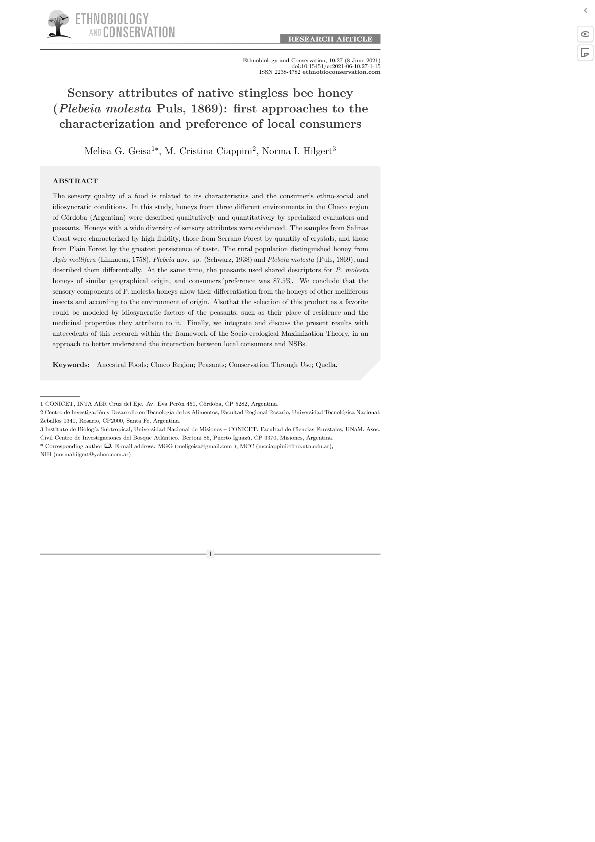Mostrar el registro sencillo del ítem
dc.contributor.author
Geisa, Melisa Gabriela

dc.contributor.author
Ciappini, Maria Cristina

dc.contributor.author
Hilgert, Norma Ines

dc.date.available
2022-11-23T12:15:06Z
dc.date.issued
2021-06
dc.identifier.citation
Geisa, Melisa Gabriela; Ciappini, Maria Cristina; Hilgert, Norma Ines; Sensory attributes of native stingless bee honey (Plebeia molesta Puls, 1869): first approaches to the characterization and preference of local consumers; Universidade Federal Rural de Pernambuco; Ethnobiology and Conservation; 10; 27; 6-2021; 1-15
dc.identifier.issn
2238-4782
dc.identifier.uri
http://hdl.handle.net/11336/178651
dc.description.abstract
The sensory quality of a food is related to its characteristics and the consumer?s ethno-social andidiosyncratic conditions. In this study, honeys from three different environments in the Chaco regionof Córdoba (Argentina) were described qualitatively and quantitatively by specialized evaluators andpeasants. Honeys with a wide diversity of sensory attributes were evidenced. The samples from Salinas Coast were characterized by high fluidity, those from Serrano Forest by quantity of crystals, and those from Plain Forest by the greatest persistence of taste. The rural population distinguished honey from Apis mellifera (Linnaeus, 1758), Plebeia nov. sp. (Schwarz, 1938) and Plebeia molesta (Puls, 1869), and described them differentially. At the same time, the peasants used shared descriptors for P. molesta honeys of similar geographical origin, and consumers´preference was 87.5%. We conclude that the sensory components of P. molesta honeys allow their differentiation from the honeys of other melliferous insects and according to the environment of origin. Alsothat the selection of this product as a favorite could be modeled by idiosyncratic factors of the peasants, such as their place of residence and the medicinal properties they attribute to it. Finally, we integrate and discuss the present results with antecedents of this research within the framework of the Socio-ecological Maximization Theory, in an approach to better understand the interaction between local consumers and NSBs.
dc.format
application/pdf
dc.language.iso
eng
dc.publisher
Universidade Federal Rural de Pernambuco
dc.rights
info:eu-repo/semantics/openAccess
dc.rights.uri
https://creativecommons.org/licenses/by/2.5/ar/
dc.subject
ANCESTRAL FOODS
dc.subject
CHACO REGION
dc.subject
PEASANTS
dc.subject
CONSERVATION THROUGH USE
dc.subject
QUELLA
dc.subject.classification
Conservación de la Biodiversidad

dc.subject.classification
Ciencias Biológicas

dc.subject.classification
CIENCIAS NATURALES Y EXACTAS

dc.title
Sensory attributes of native stingless bee honey (Plebeia molesta Puls, 1869): first approaches to the characterization and preference of local consumers
dc.type
info:eu-repo/semantics/article
dc.type
info:ar-repo/semantics/artículo
dc.type
info:eu-repo/semantics/publishedVersion
dc.date.updated
2022-10-11T14:06:51Z
dc.journal.volume
10
dc.journal.number
27
dc.journal.pagination
1-15
dc.journal.pais
Brasil

dc.journal.ciudad
Pernambuco
dc.description.fil
Fil: Geisa, Melisa Gabriela. Instituto Nacional de Tecnología Agropecuaria. Centro Regional Córdoba; Argentina. Consejo Nacional de Investigaciones Científicas y Técnicas; Argentina
dc.description.fil
Fil: Ciappini, Maria Cristina. Universidad Tecnológica Nacional. Facultad Regional Rosario; Argentina
dc.description.fil
Fil: Hilgert, Norma Ines. Consejo Nacional de Investigaciones Científicas y Técnicas. Centro Científico Tecnológico Conicet - Nordeste. Instituto de Biología Subtropical. Instituto de Biología Subtropical - Nodo Puerto Iguazú | Universidad Nacional de Misiones. Instituto de Biología Subtropical. Instituto de Biología Subtropical - Nodo Puerto Iguazú; Argentina. Consejo Nacional de Investigaciones Científicas y Técnicas. Centro Científico Tecnológico Conicet - Nordeste; Argentina
dc.journal.title
Ethnobiology and Conservation
dc.relation.alternativeid
info:eu-repo/semantics/altIdentifier/url/https://www.ethnobioconservation.com/index.php/ebc/article/view/515/322
dc.relation.alternativeid
info:eu-repo/semantics/altIdentifier/doi/http://dx.doi.org/10.15451/ec2021-06-10.27-1-15
Archivos asociados
